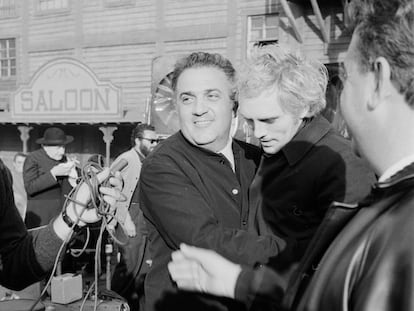The difficulty of bringing Super Mario Bros to life on the big screen: ‘Mario embodies the power of those who are traditionally powerless’
Nintendo’s iconic hero will be voiced by Chris Pratt when the film hits theaters on April 5. But the character runs the risk of losing the essential quality that made him appealing and allowed us to identify with him
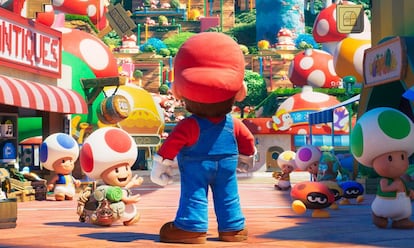
There was a time, three decades ago, when Sonic the Hedgehog and Mario were equally popular. The famous animal was the mascot of the video console company Sega, while the Italian plumber was the star of its competitor Nintendo; both of them sold video games by the millions. But Mario is the one whose first animated movie will debut in theaters on April 5. Over the years, Mario has come to transcend video games and is famous on a par with Mickey Mouse. How has he managed to do it? For starters, Mario has shed something that Sonic the Hedgehog had in spades: personality.
Sonic belonged to a wave of 1990s rogue mascots, led by Bart Simpson. He was followed by Fido Dido (the spiky-haired grunge kid created by Joanna Ferrone and Sue Rose for Seven Up, who got his own video game, snack and hair gel), Cheetos’ Chester (the cheetah with sunglasses that Brad Morgan created for Matutano) and other forgotten video game heroes like Spyro the Dragon and Cool Spot (literally, a badge with sunglasses): they all conveyed a rebellious, cocky and individualistic attitude toward life that aligned them with Generation X. Like all trends, this one was doomed to go out of style. In this context, Sonic’s wiseacre expression contrasted with Mario’s ever-arched eyebrows; the latter was a cheerful plumber who accidentally stumbled on extraordinary adventures.
Since his 1981 debut, Mario has barely changed. Back then, he was the assistant to Nintendo’s then-star, the gorilla Donkey Kong. Originally, Mario’s creator, Shigeru Miyamoto, wanted to use Popeye for the job, but he was not granted permission to do so. Instead, he adapted tropes from the sailor (a damsel in distress kidnapped by a brute; helplessness transformed into strength by a magic plant, in this case, mushrooms instead of spinach) and made him a plumber for a specific scenario: the first videogame was set in a sewer. The character’s physical appearance also responded to technical visual needs. At the time, pixel limitations required a simple design: Mario’s cap freed his creators from having to design hair, his mustache saved them from having to give him a mouth and his outfit of blue jeans and a red T-shirt made him easier to locate on the black background. Jumping was Mario’s only function.
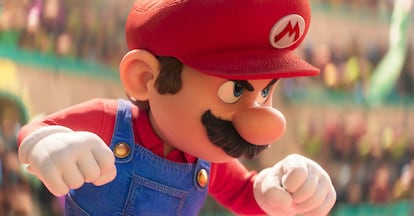
All these visual features would take on additional meaning. The mustache hid facial expressions, allowing all players to project themselves onto Mario. The energy with which he jumped — stretching out his arms in a childlike fashion — made him a hero: Mario was tenacious, relentless and tireless in pursuit of his goal to rescue the princess, a surefire theme that goes back to Arthurian legends. Mario’s profession as a plumber gave him a special skill and distinguished him from other mascots: unlike Mickey, Bugs Bunny or Sonic, Mario was a working-class immigrant who — in a none-too-subtle metaphor — busted his ass to earn coins (more salaciously, he also went berserk after eating a mushroom). Thus, Mario is a regular guy whose only superpower is the persistent determination to keep going.
Philosopher Simon May, the author of the book The Power of Cute, argues that Mario’s resilience is the main component of his legacy; he has character (if only in reaction to something) but not personality. “His power comes from his vulnerability. His fearless violence only happens as a reaction, and he doesn’t throw punches, he just jumps,” May says. “His power doesn’t come from classic power politics. And we all need resilience in our lives. We always admire people who move on, despite having horrible experiences, and those who do so nonviolently and without holding grudges. It’s a great relief given human nature’s penchant for resentment. That’s how cute characters represent us. We don’t plan anything, either; we just go through life. And Mario never gives up. He’s always ready to try again. Today, he’s more relevant than ever because he embodies the power of those who are traditionally powerless.”
Efforts to create a certain mythology around Mario have failed. In the early 1990s, a TV series and movie (starring wrestling star Lou Albano and actor Bob Hoskins, respectively) explored Mario’s everyday life; they portrayed him as a loser who shared a precarious existence in a junk-filled apartment with his brother Luigi. In the end, Mario didn’t need that much character development. To win over millions of people (he has appeared in more than 430 video games, 120 as the main character, and the Super Mario saga has sold over 500 million video games, making it the most successful franchise in history), he needed only his original traits: his profession, cheerful face and enthusiastic energy for jumping to the princess’s rescue.
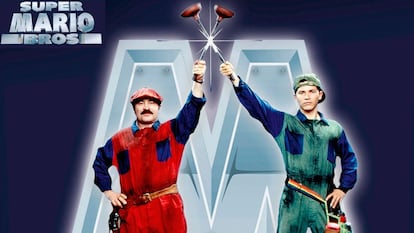
But that romantic quest does not mean that Mario has physical longings. On several occasions, Nintendo has made it clear that Mario and Peach, the princess, are just friends; that makes her an eternal romantic possibility. Who wouldn’t identify with Mario? Similarly, while Sonic’s villain is a mad scientist with steampunk aesthetics, Mario’s nemesis, Bowser, reminds you of all the schoolmates who ever bullied you. Over the past 40 years, the mustache has come and gone as a style choice, but Mario has remained relevant without having to shave his off. Mario simply needs to lack personality, which, when it comes to mascots, is more profitable than having too much of one.
Indeed, that was one of the standout lessons of the 1990s. For example, Warner Bros. attempted to transform Bugs Bunny, Daffy Duck and their friends into their own Mickey and Donald Duck through advertising campaigns, merchandising and theme parks. In a recent video essay, creator Patrick Willems pointed out that the flagship effort of this rebranding was Space Jam (1996), the film starring Michael Jordan. In the movie, the Looney Tunes — so well known for their sly humor, wacky intelligence, absurdist violence, sassy attitude, rabid individualism, lack of morals, droopy eyelids, condescending half-smiles and cross-dressing as a diversionary tactic — were stripped of the personality and character that had made them icons for decades. They ceased to be anarchic and became lucrative.
This neutralization process is similar to the one Disney enacted with Mickey Mouse, who has stopped starring in adventures (in hundreds of pre-World War II short films, he exhibited a clumsy and unaware character and a naive, cowardly and dependent personality) and has been watered down to the point of becoming an empty commercial symbol that simply evokes good feelings. Then there’s Donald, who has ceased to be an ill-tempered duck and become nothing more (and nothing less) than a Disneyland costume. And Tweety Bird went from a complex character (he was both a victim and a sadist) to an illustration on sexy T-shirts. “For a character to work as a brand,” Willems points out, “you have to remove everything that makes him a character, from conflict to dramatic development.” The operation turned out to be a financial success: Space Jam grossed 245 million euros ($245 million) (two years ago, its sequel grossed 150 million euros — $164 million — but cost 140 million euros — $153 million — to make).
Simon May notes that the cult of cuteness exploded after World War II. Japan needed to present itself to the world as an unthreatening nation; thus, it created cute cultural artifacts like Hello Kitty and Mario. According to May, these characters succeed in a world eager to abandon extreme labels. They are presented as creatures that blur the lines between child and adult, human and animal and male and female. “Super Mario connects with the current zeitgeist of fluidity,” the philosopher explains, “We are witnessing the collapse of rigid dichotomies. The most obvious one right now is that of gender.”
Mario also bridges borders between countries because he lacks patriotism, even though he is clearly identified as Italian. He appeared at the closing ceremony of the 2016 Rio Olympic Games to take the Olympic torch on Tokyo’s behalf and even has a street in Zaragoza, Spain named after him (Super Mario Bros Avenue). Unlike Sonic the Hedgehog, the universal values that Mario represents do not change with a particular era’s youth trends but rather have timeless and global appeal: justice, generosity, sacrifice, humility, persistence and excellent physical condition. He is a non-character, but millions of people still think they know him very well.
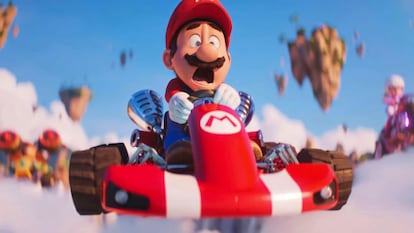
Mario doesn’t need to appeal to nostalgia; as long as goodness and pipes exist, he won’t go anywhere. His lack of personality may have made him a soft mascot compared to the cool kids of the 1990s, but it has proven to be his best asset in the long run. He hasn’t had to adapt to the zeitgeist because the culture of the times has adapted to him. Unlike Mickey or Bugs Bunny, he didn’t have to become less provocative because he never was in the first place. He’s the perfect mascot for our times. “Mario has fun overcoming the obstacles he faces,” notes Simon May. “He’s confident but not cynical. He may not have a personality in the traditional sense of the term because he’s fluid, but he’s not a blank canvas. He has meaning. Vulnerability, helplessness and victimhood are increasingly prominent concepts in cultural discourse, and of course no country understands that more viscerally than Japan.”
On the day the Super Mario Bros: The Movie trailer came out, many fans protested the fact that Chris Pratt was voicing the character. Some expressed anger because of the actor’s alleged conservative tendencies and accusations of homophobia based on his affiliation with an evangelical church, while others complained that Pratt’s voice was nothing like the one Mario had in the animated series they grew up with. In the original version, Charles Martinet’s voice parodied all sorts of stereotypes of Italians, complete with an accent and likes (pizza, pasta, lasagna); these were unavoidable references in the 1990s, but they’re unacceptable in 2023. Martinet has been giving voice to Mario for three decades, and his voice is the one identified with the character, who barely speaks. Ultimately, fans may fear that if they get to know more about their favorite plumber, they may not like what they find out. The film is bound to develop a concrete identity for someone who has been successful for four decades without one. It remains to be seen whether Mario will spoil all that just by opening his mouth.
Sign up for our weekly newsletter to get more English-language news coverage from EL PAÍS USA Edition
Tu suscripción se está usando en otro dispositivo
¿Quieres añadir otro usuario a tu suscripción?
Si continúas leyendo en este dispositivo, no se podrá leer en el otro.
FlechaTu suscripción se está usando en otro dispositivo y solo puedes acceder a EL PAÍS desde un dispositivo a la vez.
Si quieres compartir tu cuenta, cambia tu suscripción a la modalidad Premium, así podrás añadir otro usuario. Cada uno accederá con su propia cuenta de email, lo que os permitirá personalizar vuestra experiencia en EL PAÍS.
¿Tienes una suscripción de empresa? Accede aquí para contratar más cuentas.
En el caso de no saber quién está usando tu cuenta, te recomendamos cambiar tu contraseña aquí.
Si decides continuar compartiendo tu cuenta, este mensaje se mostrará en tu dispositivo y en el de la otra persona que está usando tu cuenta de forma indefinida, afectando a tu experiencia de lectura. Puedes consultar aquí los términos y condiciones de la suscripción digital.
More information
Archived In
Últimas noticias
Petro claims the ELN was the target of US attack in Venezuela
Maduro counterattacks Trump with rhetoric and announces downing of nine drug trafficking aircraft
‘Ecce Homo’: The miraculous disaster that made a small Spanish town famous
Return to sex testing at the Olympics: IOC edges closer to banning transgender women
Most viewed
- Sinaloa Cartel war is taking its toll on Los Chapitos
- Oona Chaplin: ‘I told James Cameron that I was living in a treehouse and starting a permaculture project with a friend’
- Reinhard Genzel, Nobel laureate in physics: ‘One-minute videos will never give you the truth’
- Why the price of coffee has skyrocketed: from Brazilian plantations to specialty coffee houses
- Silver prices are going crazy: This is what’s fueling the rally

